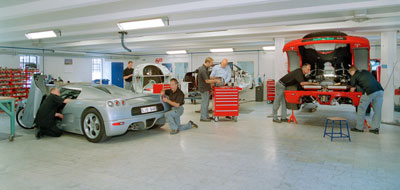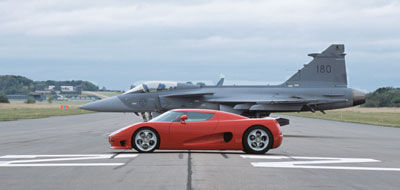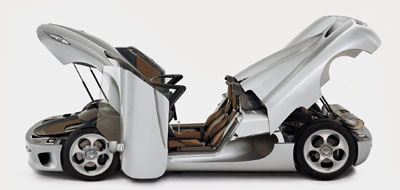Swedish Supercar
Many small-run manufacturers have tried to ‘create the ultimate supercar’. The result is often an unhappy marriage between proprietary components and styling from the back of a 4th Former’s exercise book. Swedish manufacturers Koenigsegg also make this claim but this time it’s backed up by thorough engineering practice, exciting styling and a finished car that has received rave reviews from the motoring press worldwide.
The Koenigsegg CC8S, to give the car its full title, is built along the classic mid-engined supercar principles, motive power coming from a supercharged 655bhp V8. Clothed in elegant, and aerodynamically functional, bodywork it’s capable of extraordinary performance; such as 0-62mph in less than 3.5 seconds – the blistering acceleration carrying its 1175kgs on to a maximum speed of 240mph. This is McLaren F1 territory, indeed the car has made it into the Guinness book of records as the most powerful production car available. Impressive for a brand new manufacturer, but in this segment performance is important - but it’s not all. The car has to bear close scrutiny from a discerning clientele wishing to use it for longer trips than just track-day work.
It certainly looks the part. The bodywork features large ‘clamshell’ bonnet and boot covers as well as one of its unique features – the flip-forward, out and down doors (Dihedral Synchro-Helix Door Actuation to be precise) that allow an easy entrance to the passenger compartment in areas of restricted space. The car is a coupé, but also benefits from a removable ‘targa’ top (with a clear, built-in roof panel) that can be placed under the bonnet together with 120 litres of luggage. The company claims the shape of the body is inspired by “design by nature”, a combination of influences from the animal and bird world. It is impressive. Subtle yet dramatic, it’s less ‘in your face’ than a Lamborghini Countach. Perhaps it really does inherit the mantle of the McLaren F1 as a design with purpose rather than simply to shock - and I like it.


 Stay informed! Subscribe here to our weekly newsletter.
Stay informed! Subscribe here to our weekly newsletter.
Under the skin
Under the carbon-fibre/Kevlar/light foam sandwich body there is a semi-monocoque chassis made of carbon-fibre with honeycomb sections to add stiffness and contribute to the car’s very ‘Swedish’ level of passenger safety. When tested at the country’s Autoliv crash-test centre it performed very well – so much so that Autoliv claimed it to be one of the safest cars they have ever seen. Front and rear subframes provide mounting points for the suspension and transaxle, and the composite monocoque extends to the distinctive roll-over hoops behind the passenger’s and driver’s heads.
For those who like motor-racing-standard fabricated components, the Koenigsegg will not disappoint. With generous access via the doors, bonnet and boot there is a lot of mechanical gadgetry on display and following accepted race practices of materials and finish, a plethora of turned, anodised or plated parts are on show. It’s a work of art underneath. The adjustable Öhlins Racing gas-hydraulic shock absorbers are connected to the double wishbones via pushrods, and a generous mixture of chrome molybdenum, CAD/CAM machined from billet alloy and carbon-fibre forms the suspension set-up. Braking is achieved via colossal six-pot calipers up front (coupled with 345mm ventilated discs) and four-pot/330mm at the back.
The engine of course provides the thrust to launch a merely good-looking, well-finished car with superlative handling into the record books. Loosely production-based, the 4,700cc cast aluminium V8 weighs only 210kgs and benefits from liberal use of all the exotic materials available to the racing industry. Indeed the cylinder heads and block are manufactured by Teksid in Carmagnola, Italy who also supply engine blocks to the Ferrari F1 team. A dry-sump arrangement means the engine sits lower in the chassis, improving handling and weight distribution. The phenomenal power and torque is transmitted to the 315/40 ZR 18 (335/30 ZR 20s are an option) rear tyres by a six speed sequential transaxle gearbox, specially built for the car by Cima (another Ferrari F1 supplier).


Bespoke ownership
The potential Koenigsegg owner will harness all this power and technology from a very modern cockpit that features the push-pull gear lever and all metal surfaces finished in machined and anodised aluminium - the rest being a leather and Alcantara mix. American space scientists NASA have developed a special material ‘Tempur’, and this is used as one of the coverings of the carbon-fibre seats. The interior is stylish, and just on the right side of modern and design-led without being garish.
To summarise, the whole project is a fantastic achievement for a company based in a country not noted for a supercar industry (although being well in the forefront for safety, design and engineering, as well as providing a never-ending stream of top rally and racing drivers). From building the first prototype in 1996, the CC8S is now mentioned in the same breath as the Ferrari Enzo, Pagani Zonda and McLaren F1. It looks great, strikes the right note in market taste and quality - and clearly has the performance to destroy almost anything on-track and off it.
So who would buy one? The person who may choose Bang & Olufson over Bose or Quad. Someone who knows their mind and does not follow the herd - but recognises quality when they see it.
As the owner, Christian von Koenigsegg, says “A car built for those who like to stand apart – for those who dare to go beyond the borders of tradition”. That seems a good summary to me.
Photos: Koenigsegg / Words: Steve Wakefield
The worldwide RHD distributor for the Koenigsegg CC8S is Modena Cars, based in the in the UK.


The facts
| Engine: | Cast aluminium V8 4,700cc Supercharged Coil on plug ignition Double overhead cam, 4 valve head Dry sump Compression ratio 8.6:1 |
| Power: | 655 bhp @ 6800 rpm |
| Torque: | 553 lb/ft @ 5000 rpm |
| Transmission: | Six speed sequential transaxle. LSD, dual plate clutch. |
| Suspension: | Double wishbone suspension front and rear Adjustable pushrod-activated Öhlins Racing gas-hydraulic shock absorbers Electronically adjustable ride-height |
| Brakes: | Front; Ventilated 345mm disc, 6 piston light alloy caliper Rear; Ventilated 330mm disc, 4 piston light alloy caliper |
| Body: | Two door, two seat coupe with removable hardtop Body made of pre-impregnated carbon fibre/kevlar and lightweight hard-foam sandwich construction |
| Wheels: | 18" Koenigsegg magnesium alloy wheels (optional 20") with centre locking, 9" wide front, 12" wide rear |
| Tyres: | Unidirectional with asymmetric tread pattern Front; 245/40 ZR18 (optional 255/40 ZR18) Rear; 315/40 ZR18 (optional 335/40 ZR20) |
| Dry Weight: | 1175 kg |
| Performance: |
Top speed; 390 kmh/240 mph Standing quartermile; 10 secs. Terminal speed; 135 mph Acceleration 0-100 kmh/62 mph; under 3.5 secs |
| RHD Price: | From £365,000 |





